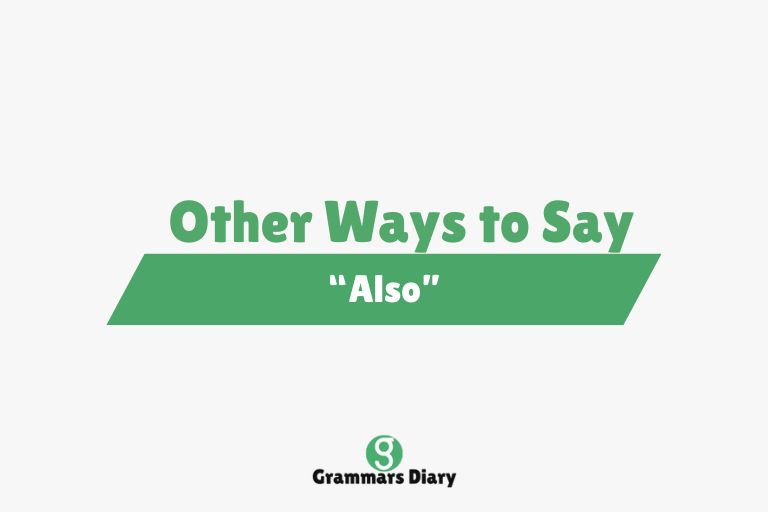“Also” is one of the most frequently used adverbs in English, helping to add information, connect thoughts, or emphasize a point in both speech and writing. For example, when someone says, “She loves reading, and she also enjoys painting,” the word “also” acts as a bridge to include another idea or detail without starting a new sentence or sounding repetitive.
However, relying on the word “also” too often can make your language feel monotonous, especially in professional, academic, or creative writing. Fortunately, the English language offers a wide variety of synonyms and expressions that can substitute for “also,” each carrying slightly different tones, levels of formality, and appropriate contexts. This article explores twenty alternatives to “also” that can help you express additional thoughts more clearly and effectively.
Other Ways to Say “Also”
1. As well
Example: “He speaks French as well as Spanish.”
Meaning: Used to include an additional point or element, typically placed at the end of a sentence.
Usage: Common in spoken and informal written English, especially to emphasize a second item or detail.
2. In addition
Example: “In addition to her degree in biology, she holds a master’s in chemistry.”
Meaning: A formal way to introduce another point or piece of information.
Usage: Frequently used in academic, business, and formal writing to extend arguments or ideas logically.
3. Too
Example: “I’m going to the concert, and she’s coming too.”
Meaning: Functions similarly to “also,” generally placed at the end of a sentence.
Usage: Very casual and conversational, suitable for informal contexts.
4. Furthermore
Example: “The product is affordable; furthermore, it’s eco-friendly.”
Meaning: Adds emphasis to an additional or reinforcing point.
Usage: Often used in persuasive or argumentative writing, where formality is preferred.
5. Moreover
Example: “She’s a skilled coder; moreover, she’s an excellent communicator.”
Meaning: Indicates that the next point is not only additional but possibly more significant.
Usage: Common in essays, reports, or articles where a strong, formal tone is required.
6. Additionally
Example: “Additionally, the report outlines the proposed timeline for the project.”
Meaning: Introduces another fact or statement that complements the one before.
Usage: Preferred in academic or technical writing to maintain a structured flow of ideas.
7. Besides
Example: “I’m too tired to go out; besides, it’s raining.”
Meaning: Offers an extra reason or justification in a slightly casual tone.
Usage: Common in both conversation and informal written contexts to support or extend an argument.
8. Not to mention
Example: “He’s a talented writer, not to mention an excellent public speaker.”
Meaning: Used to add something that makes a previous statement even stronger.
Usage: Slightly idiomatic; works well in creative or persuasive writing.
9. What’s more
Example: “The offer includes free delivery. What’s more, you’ll get a discount on your next purchase.”
Meaning: Emphasizes a particularly interesting or surprising addition.
Usage: Effective in conversational writing or advertising copy for added flair.
10. Plus
Example: “She’s great at her job, plus she always helps her coworkers.”
Meaning: Informal synonym for “also” that’s used to connect additional positive traits or benefits.
Usage: Widely used in casual conversations and informal writing.
11. Likewise
Example: “He enjoys hiking; likewise, his sister is passionate about outdoor activities.”
Meaning: Suggests a similarity or shared attribute between two subjects.
Usage: Common in formal and semi-formal writing when comparing or linking similar ideas or behaviors.
12. Similarly
Example: “The north region has seen economic growth; similarly, the south is also improving.”
Meaning: Highlights a comparable or parallel situation.
Usage: Useful in academic and analytical writing to demonstrate connections or trends.
13. Correspondingly
Example: “Their expenses decreased; correspondingly, their savings increased.”
Meaning: Suggests that one change happens in direct relation to another.
Usage: Found in technical or formal analysis, often to show cause-and-effect relationships.
14. Along with that
Example: “She submitted the application; along with that, she emailed her resume.”
Meaning: Indicates an additional action taken at the same time.
Usage: Informal to semi-formal; useful in narrative or procedural writing.
15. Coupled with
Example: “High humidity, coupled with soaring temperatures, made the day unbearable.”
Meaning: Combines two ideas that occur together, often to amplify the result.
Usage: Often used in descriptive or expository writing.
16. On top of that
Example: “He was late for the meeting, and on top of that, he forgot his notes.”
Meaning: Adds emphasis to an already negative or surprising detail.
Usage: Casual and expressive; often found in storytelling or dialogue.
17. Over and above that
Example: “Over and above that, the program includes mentorship opportunities.”
Meaning: Highlights an additional advantage or bonus.
Usage: Slightly formal and often used to underscore value or importance.
18. In like manner
Example: “The first chapter introduces the theory. In like manner, the second chapter builds on the concepts.”
Meaning: Offers a mirrored or consistent approach in explanation or logic.
Usage: Often used in formal essays or comparative writing.
19. By the same token
Example: “She deserves recognition for her effort; by the same token, so does her team.”
Meaning: Indicates equal treatment or justification.
Usage: Formal or persuasive writing where fairness or balance is emphasized.
20. Equally
Example: “Both solutions are equally effective in reducing energy costs.”
Meaning: Emphasizes parity or balance between two options or ideas.
Usage: Common in analytical and informative writing to stress equality.
When to Use Different “Also” Alternatives
In Professional Settings
In formal business or workplace communication, phrases like “in addition,” “furthermore,” “additionally,” and “moreover” are ideal, as they maintain professionalism while enhancing clarity and flow. These expressions help to organize ideas effectively in presentations, reports, and proposals.
In Everyday Conversations
In casual dialogue or informal writing, shorter alternatives such as “too,” “as well,” “plus,” and “on top of that” keep the tone friendly and natural. These words work well when you’re chatting with friends, sending texts, or crafting social media posts.
In Academic or Formal Writing
When writing essays, research papers, or academic content, precise expressions like “similarly,” “correspondingly,” “likewise,” and “by the same token” help maintain coherence and logical progression between complex ideas. These alternatives offer depth and clarity without being repetitive.
Conclusion
The word “also” is a simple and functional part of the English language, but with a richer vocabulary at your fingertips, you can bring variety, tone, and clarity to your writing or speaking. Choosing the right alternative for “also” depends on the context and purpose of your communication—whether you need something more formal, casual, persuasive, or descriptive.
Exploring synonyms not only enhances your expression but also strengthens your overall writing style. For those looking to expand even further, Thesaurus.com offers an excellent collection of related words and phrases.
FAQs
What does “also” mean?
“Also” is used to add or include something else, indicating that another point, fact, or person is involved in addition to what has already been mentioned.
Is “also” formal or informal?
“Also” is a neutral word that fits both formal and informal contexts, but depending on tone or audience, alternatives like “moreover” or “plus” may be more suitable.
Can I use “also” at the beginning of a sentence?
Yes, although it’s better to vary placement. Alternatives like “in addition” or “furthermore” are more suitable for starting formal sentences without sounding repetitive.
What’s the difference between “also” and “too”?
Both mean the same thing, but “too” is typically used at the end of a sentence in informal contexts, while “also” is more flexible in sentence position and formality.











